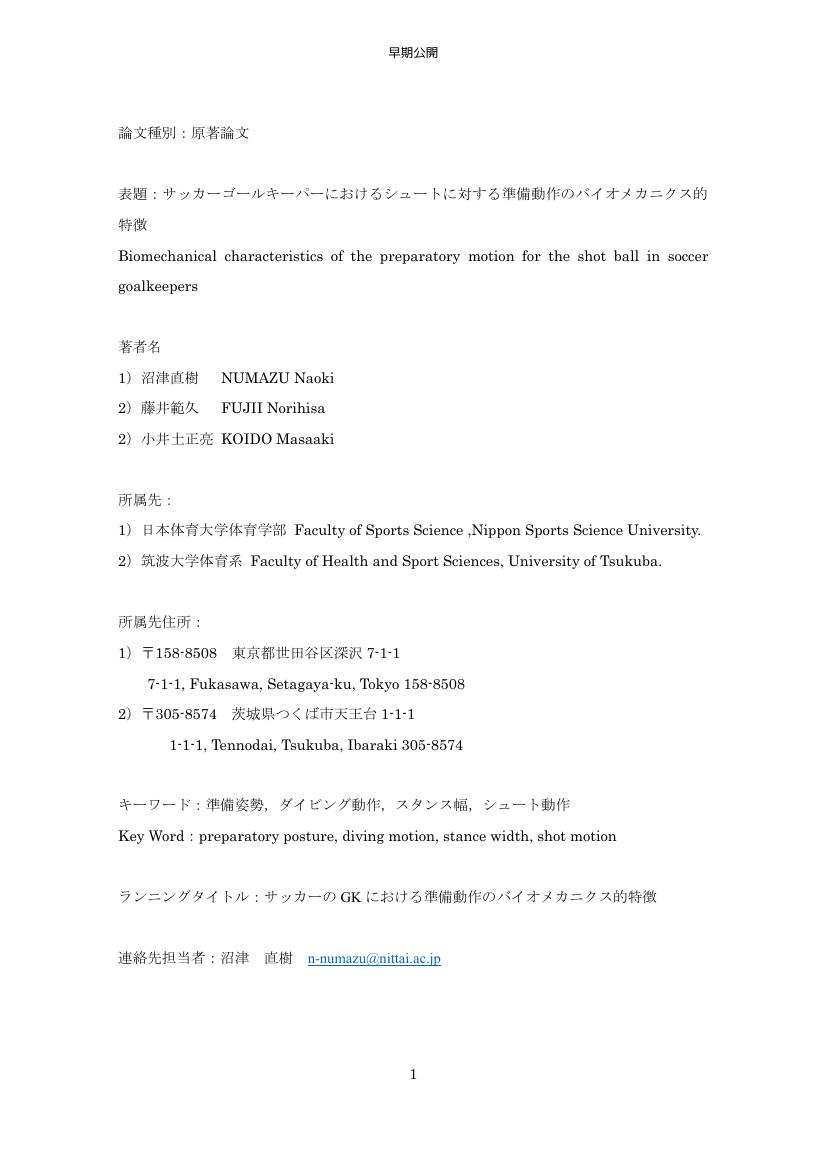3 0 0 0 OA サッカーゴールキーパーにおけるシュートに対する準備動作のバイオメカニクス的特徴
- 著者
- 沼津 直樹 藤井 範久 小井土 正亮
- 出版者
- 一般社団法人 日本体育・スポーツ・健康学会
- 雑誌
- 体育学研究 (ISSN:04846710)
- 巻号頁・発行日
- vol.67, pp.519-536, 2022 (Released:2022-07-08)
- 参考文献数
- 31
This study aimed to clarify the biomechanical characteristics of preparatory motions required for defensive diving by soccer goalkeepers (GKs). Seventeen collegiate male GKs and 14 collegiate male outfield players (strikers) participated. The experimental setup was based on a previous study (Numazu et al., 2019), and the experiment was conducted using simulated shooting situations in the penalty area. Three-dimensional coordinate data for the GKs and strikers were captured using 2 motion capture systems with 24 cameras (250 Hz, 16 cameras for the GKs and 8 cameras for the strikers). The 2 systems were synchronized by an analog signal (1000 Hz). We analyzed 430 trials where the GKs dived toward the shot (NU: 75 trials, NM: 94 trials, NL: 37 trials, FU: 58 trials, FM: 83 trials, and FL: 83 trials). The participating GKs performed a small jumping motion vertically upward, similar to a split-step, as a preparatory motion. The primary variables computed were as follows: elapsed time of preparatory motion, velocity of the center of gravity at takeoff in the frontal plane, stance width divided by leg length, height of preparatory motion, segment angle of the trunk in the sagittal plane, and angles of the lower limb joints. The major findings were as follows: 1) To respond quickly to the shot, the GKs leaned the trunk forward and flexed the lower leg joints, externally rotated the hip joints of both legs, abducted the hip joints, and opened the feet to 70% of the leg length. 2) GKs performed the take-off of the preparatory motion simultaneously when the striker made contact between the support leg and the ground. 3) It was considered that GKs changed their movement to match the flight trajectory of the ball later than CSon.
1 0 0 0 OA サッカーゴールキーパーにおけるシュートに対する準備動作のバイオメカニクス的特徴
- 著者
- 沼津 直樹 藤井 範久 小井土 正亮
- 出版者
- 一般社団法人 日本体育・スポーツ・健康学会
- 雑誌
- 体育学研究 (ISSN:04846710)
- 巻号頁・発行日
- pp.21157, (Released:2022-05-14)
- 著者
- 沼津 直樹 藤井 範久 森本 泰介 小池 関也
- 出版者
- バイオメカニズム学会
- 雑誌
- バイオメカニズム (ISSN:13487116)
- 巻号頁・発行日
- vol.25, pp.21-32, 2020 (Released:2021-07-16)
- 参考文献数
- 14
本研究ではキッカーにゴールのさまざまな地点へシュートさせ, ゴールキーパー (GK) が実際にダイビング動作によって対応した試技のシュート動作を対象に, GKがシュートの飛来する地点を予測する際に有用なキッカーやボールの動きについてバイオメカニクス的に検討することを目的とした. その結果, 右利きのキッカーが自身の左方向へシュートを行う際, 軸脚の足部や体幹の回旋角度が, 右方向へシュートする場合よりもより左方向へ向くことが明らかとなった. また, シュートがGKの近くまたは遠くに飛来するのかといったシュートの距離や飛来するシュートの高さについては, インパクト後のボールの軌道から素早く判断し, 対応しなければならないことが明らかとなった.
- 著者
- 沼津 直樹 藤井 範久 小井土 正亮
- 出版者
- 一般社団法人 日本体育・スポーツ・健康学会
- 雑誌
- 体育学研究 (ISSN:04846710)
- 巻号頁・発行日
- vol.64, no.2, pp.647-664, 2019-12-16 (Released:2019-12-20)
- 参考文献数
- 23
- 被引用文献数
- 1 1
The purpose of this study was to clarify the biomechanical characteristics of soccer goalkeepers (GKs) diving for shots placed distantly from the GK. Fifteen collegiate male GKs and 13 collegiate male outfield players acting as strikers participated. The experimental situation involved shooting from inside the penalty area. The strikers were instructed to execute an instep kick placing the ball 16.5 m away from the GK after pushing the ball forward. The GKs were instructed to dive with a preparatory motion toward the shot ball. Three-dimensional coordinate data for the strikers and GKs were captured using 2 motion capture systems – one with 16 cameras for the GKs and the other with 8 cameras for the strikers (250Hz). The systems were synchronized with an analog signal via an A/D converter (1000 Hz) and input to a computer. The shooting areas were divided into 12 (i.e. 2 shooting directions to the right and left sides of the GKs, 2 shooting distances close to and far from the GKs, and 3 shot heights, close to the ground, and also at high and medium heights). The strikers were informed of the target shooting area randomly in each trial, and 213 trials in which the GKs dived toward shots placed in the far area were selected. We calculated the velocity of the center of gravity and the joint angles of the lower limbs. The major findings were as follows. 1) Regardless of shooting height, it appeared that the GKs performed almost the same motion until landing because they began to move after determining the diving direction. 2) In order to dive to lower-placed balls, leaning the trunk towards the diving direction was necessary to allow placement of the hand in the lower position. 3) Regardless of shooting height, the side contralateral (CS) to the leg in the diving direction had the same role of achieving movement of the center of gravity in the diving direction. 4) The GKs dived toward lower-placed shots by flexing the knee joint of their CS leg and the hip and knee joints of their ball side (BS) leg before the BS leg touched the ground. 5) The GKs dived towards individual shot heights by appropriately adjusting the posture of their BS leg before the BS leg touched the ground.
